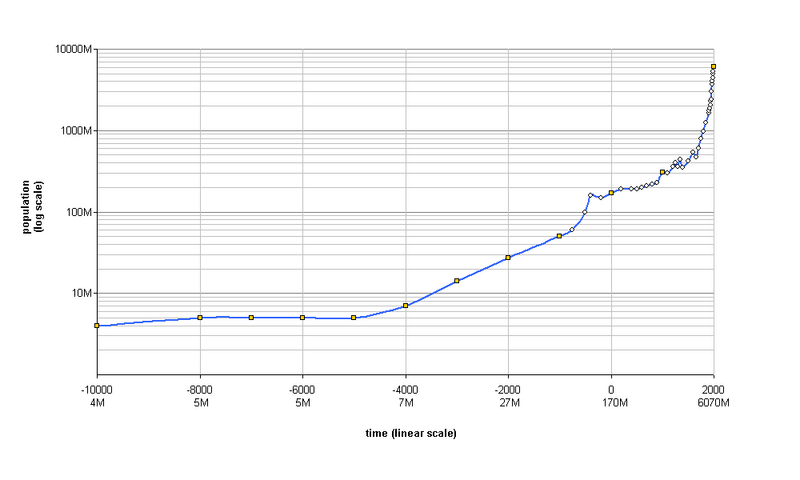
The logical trend would show that about 4-5000BC there was a "beginning" of the present world population.
“Annually there are always more births than deaths...I don’t deny that there could have been some unlikely years of decrease or stagnancy, but the consistent trend of all creatures has always been growth and increase and this indicates (if not outright proves) that the human race is relatively young....”
Such a notion is pure ignorance and nonsense. The occurrence of more deaths than births in an annual time period is very common in human history and in non-human populations. In the non-human populations such a greater number of deaths than births is what results in the extinction of the population, and we have innumerable examples of non-human population extinctions. We also have numerous examples of various human populations, meaning different sub-groups of humans.
Up to somewhere between 75 percent to around 90 percent of the Amerindian populations in the New World succumbed to diseases before and after the Columbian colonizations. In the pre-Columbian period a number of Amerindian populations were seriously diminished by recurrent hemorrhagic fever pandemics. Inter-tribal warfare resulted in the massacre and extinction of enemy tribes down to the last man, woman, and child. Thriving Amerindian communities in such widely separated locales as Illinois, the Yucatan, and the Amazon were so depopulated by disease, economic collapse, and other events, Nature reclaimed the cultivated and urbanized landscapes and restored them to primeval conditions.
The Black Death destroyed something on the order of one-third of Europe’s entire population. Many European communities reverted to forest and prarie following this great pandemic. China’s population suffered even greater death tolls from the black plague and a number of other plagues. The Mongols depopulated Iran by exterminating every man, woman, child, dog, and other beast in the cities and communities resisting their conquests. Those few populations that survived were reduced even further by famine and disease when the Mongols destroyed the irrigations systems and the agriculture of Iran.
Cities were by and large great death traps. Without a constant influx of population from the rural communities to provide a replacement population to offset population loss from higher rates of disease, the population of the city dropped dramatically until the city was abandoned and fell into ruin. The population of Rome always fell to a fraction of its former size during periods in which the lack of economic opportunity in the city discouraged the larger influx of people from the healthier rural communities.
When the Han people of China tried to expand their population in to the tropical region south of the Yellow River, their colonies were repeatedly destroyed by the disease pool of the new environment they encountered. The Han rulers resorted to ordering repeated colonization attempts over a period of around 500 years before the colonial populations developed enough immunities to survive and expand the colonies south of the Yellow River.Until then, the number of deaths exceeded the number of births in these tropical colonies.
The bottomline is the reality that your mathematical exercise is based upon blatantly false assumptions about the rates of birth and death in the population. Until the most recent century or centuries, the death toll of humans often exceeded the birth rate to such a degree as to reduce the total humand population by greater and lesser fractions at varoius times in human history and human pre-history.
“In the non-human populations such a greater number of deaths than births is what results in the extinction of the population, and we have innumerable examples of non-human population extinctions. We also have numerous examples of various human populations, meaning different sub-groups of humans.”
Sure, but that tells us nothing about the average population growth rate of all humans. We know the total growth rate, on average, must be positive from day 0 until now, so the only question is how large is the average growth rate? Maybe he is overestimating it at 4.5%, but then what is the real figure? Is the rate which would be consistent with humans being 100,000 years old also consistent with observed human growth rates or not?
I tried to use a reverse compound interest figure to get an estimate, but putting in 100,000 years for the calculation crashed the script :)

The logical trend would show that about 4-5000BC there was a "beginning" of the present world population.